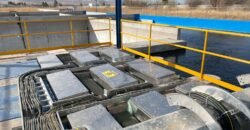How Much Water Should Be In Brine Tank
Understanding Brine Tanks: An In-Depth Guide to Water Levels
Water softening systems are essential for households relying on well water or municipal water that is high in minerals like calcium and magnesium. One critical component of these systems is the brine tank, which contains a salt solution used to regenerate the resin beads that soften the water. It’s essential to maintain the correct water level in the brine tank for optimal performance. This comprehensive guide will delve into the importance of proper water levels in brine tanks, how to determine the right amount of water, and common maintenance practices.
What is a Brine Tank?
A brine tank is a container used in water softening systems to hold a concentrated solution of salt (sodium chloride) and water, known as brine. When the resin beads in the water softener become saturated with hardness minerals, the system uses the brine solution to regenerate the beads. This process effectively flushes out the accumulated minerals and replaces them with sodium ions, allowing the resin to continue softening incoming hard water.
Components of a Brine Tank
-
- Tank Material: Brine tanks are typically made from polyethylene or fiberglass, helping to resist corrosion and withstand the salt’s caustic nature.
-
- Salt: This can be in the form of pellets, crystals, or blocks, depending on the type of brine tank and personal preference.
-
- Brine Solution: Formed by dissolving salt in water, it is the primary substance used for resin regeneration.
-
- Brine Well: A vertical tube inside the tank that draws concentrated brine into the water softener during the regeneration cycle.
-
- Float Valve: This component regulates the water level in the tank, preventing overflow and ensuring consistency in brine concentration.
Importance of Proper Water Levels in the Brine Tank
1. Maximizing Efficiency
One of the main reasons to maintain the appropriate water level in the brine tank is to ensure the efficient regeneration of the resin beads. If the water level is too low, the brine solution will not reach its optimal concentration, resulting in inadequate regeneration. Conversely, if the water level is too high, it may dilute the brine solution, again compromising the effectiveness of the regeneration process.
2. Preventing Salt Bridge Formation
A salt bridge occurs when the salt in the brine tank forms a hard crust at the top of the salt layer, preventing water from reaching the salt below. This can happen if there’s not enough water in the tank. A proper water level helps prevent salt bridges by ensuring that the salt is always submerged in the brine solution.
3. Extending Equipment Life
Keeping the water levels in the brine tank at a proper height can protect your water softening system from undue wear and tear. Inadequate water levels can lead to inconsistent flow rates and put extra strain on the water softener unit. This could result in more frequent repairs, reducing the overall lifespan of the equipment.
4. Optimizing Salt Usage
Understanding and controlling the water level in the brine tank can save you money on salt purchases. If the water level is consistently maintained, you will use only the amount of salt necessary for regeneration, rather than wasting it through dilution or inefficiency.
How Much Water Should Be in the Brine Tank?
Ideal Water Levels
The proper water level in a brine tank can vary depending on the model. However, as a general rule of thumb, the tank should have enough water to dissolve the salt completely while still leaving room for expansion. Here are a few pointers to gauge the optimal water level:
-
- Submersion Requirement: The salt in the tank should be covered with water by approximately 1-2 inches. This ensures that the salt is adequately dissolved to create a concentrated brine solution.
-
- Salt Level Gauge: Many modern brine tanks are equipped with a salt level gauge to help you monitor salt levels and the corresponding water levels more effectively.
-
- Check Recommendations: Consult your water softener’s manual to get precise guidelines on ideal water levels for your specific unit.
How to Determine the Right Water Level
-
- Inspect Regularly: It’s important to check the brine tank regularly to assess both salt and water levels. Doing this once a month is generally sufficient.
-
- Observe the Float Valve: The float valve controls the water level in the brine tank. Check to ensure it operates smoothly as this is crucial for maintaining the right water level.
-
- Visual Assessment: When you open the brine tank, you should be able to see the salt and assess how submerged it is. If the salt is dry and exposed, add water until it is submerged.
-
- Maintenance Cycles: After your water softener completes a regeneration cycle, check the water level as it may fluctuate based on usage and water supply. Adjust accordingly.
What Happens If the Water Level Is Too Low?
If water levels in the brine tank drop below the optimal level, several issues may arise:
-
- Ineffective Regeneration: The resin beads will not be regenerated properly, resulting in hard water flowing through your plumbing system.
-
- Increased Hardness: You may notice hard water signs such as scale buildup on faucets, dishes, and appliances.
-
- Salt Bridges: A low water level increases the risks of salt bridges forming, which prevent efficient salt dissolution and regeneration.
Signs Your Brine Tank Needs Water
-
- Clogging or Blockages: If you notice your water softener isn’t functioning correctly, it may be due to low water levels causing clogs or blockages.
-
- Hardness Increase: If hard water is coming out of your taps, this indicates your system may need a refresh.
-
- Salt Crust: The presence of a hard crust on top of the salt layer is a visual sign of insufficient water levels.
What Happens If the Water Level Is Too High?
On the contrary, having too much water in the brine tank can also lead to issues:
-
- Dilution of Brine: If the water level is excessive, the concentration of the salt may not be high enough for effective dissolution, leading to that brine solution being too weak.
-
- Overflowing Issues: High water levels can result in spilling over, which can create a mess and lead to corrosion or damage in surrounding areas.
-
- Rehydration of Salt: A salt bridge can also occur as salt absorbs moisture from the air in a high-water tank, eventually leading to salt wasting due to over-soaking.
Signs Your Brine Tank Has Too Much Water
-
- Water Spills: You may notice water spilling out of the brine tank lid or even pooling underneath it.
-
- Unusual Sounds: Hissing or gurgling sounds coming from the tank may indicate that an overflow is occurring.
-
- Low Salt Levels Report: Receiving alerts about low salt levels while water continues to spill can be a sign of high water.
Adjusting Water Levels in Your Brine Tank
Step-by-Step Guide on How to Adjust Water Levels
Maintaining the right water level in your brine tank is a straightforward process. Here’s a step-by-step guide to help you adjust water levels easily:
Materials Needed:
-
- Bucket
-
- Water hose
Steps:
-
- Turn Off the System: For safety and to prevent any errors, you should turn off your water softening unit before making adjustments.
-
- Inspect the Brine Tank: Open the brine tank and visually assess the water level. If it’s below the required level (1-2 inches above the salt), you’ll need to add more water. If it’s high, you may need to remove some water.
-
- Adding Water: If the water level is low,
-
- Use the bucket to draw clean water from a source and pour it into the brine tank until it reaches the desired level.
-
- Alternatively, you can use a hose to fill the tank directly while ensuring that the float valve is not blocked.
-
- Adding Water: If the water level is low,
-
- Remove Excess Water: If the water level is too high,
-
- Use a bucket to scoop out the excess water.
-
- Ensure not to disturb the salt layer too much when removing excess water.
-
- Remove Excess Water: If the water level is too high,
-
- Check the Float Valve: Make sure the float valve is moving freely and isn’t blocked by salt or debris. The function of the float valve is critical for maintaining proper water levels.
-
- Turn On Your System: Once you’ve adjusted the levels, turn on the water softener and let it complete a cycle to ensure everything is functioning properly.
-
- Final Inspection: After a few days, revisit the brine tank to assess if the water levels are still optimal. Make this a part of your monthly maintenance schedule.
Regular Maintenance!
Importance of Regular Checks
Like all mechanical systems, regular maintenance is crucial to ensure the longevity and efficiency of your brine tank and water softening system. Having a reliable schedule for checking the tank not only prevents issues but also allows you to catch potential problems before they escalate.
-
- Monthly Inspections: Set aside time at least once a month to check the salt and water levels in the brine tank.
-
- Resin Replacement: Be aware of when resin beads need replacement, usually every 5-10 years depending on usage and manufacturer guidelines.
-
- System Rebooting: After determining water levels, ensure to perform a full system cycle to refresh the resin beads.
Professional Help
If you’re unfamiliar or uncomfortable with adjusting water levels or maintaining your brine tank, consider reaching out to a professional. Water treatment technicians can provide servicing that includes:
-
- Full inspections of your water softener system.
-
- Maintenance recommendations.
-
- Testing water hardness levels to ensure optimal performance.
Conclusion
Maintaining the correct water level in a brine tank is critical for the efficient operation of water softening systems. Following the guidelines outlined in this article can help ensure that your system operates optimally, thus protecting your plumbing, appliances, and overall water quality.
By performing regular checks and addressing any discrepancies with water levels—either too high or too low—you can maximize your water softener’s efficiency, extend the life of its components, and achieve a high standard of water quality in your home. In a world where water quality can significantly affect daily life, understanding how to manage your brine tank can be an essential skill for homeowners.


